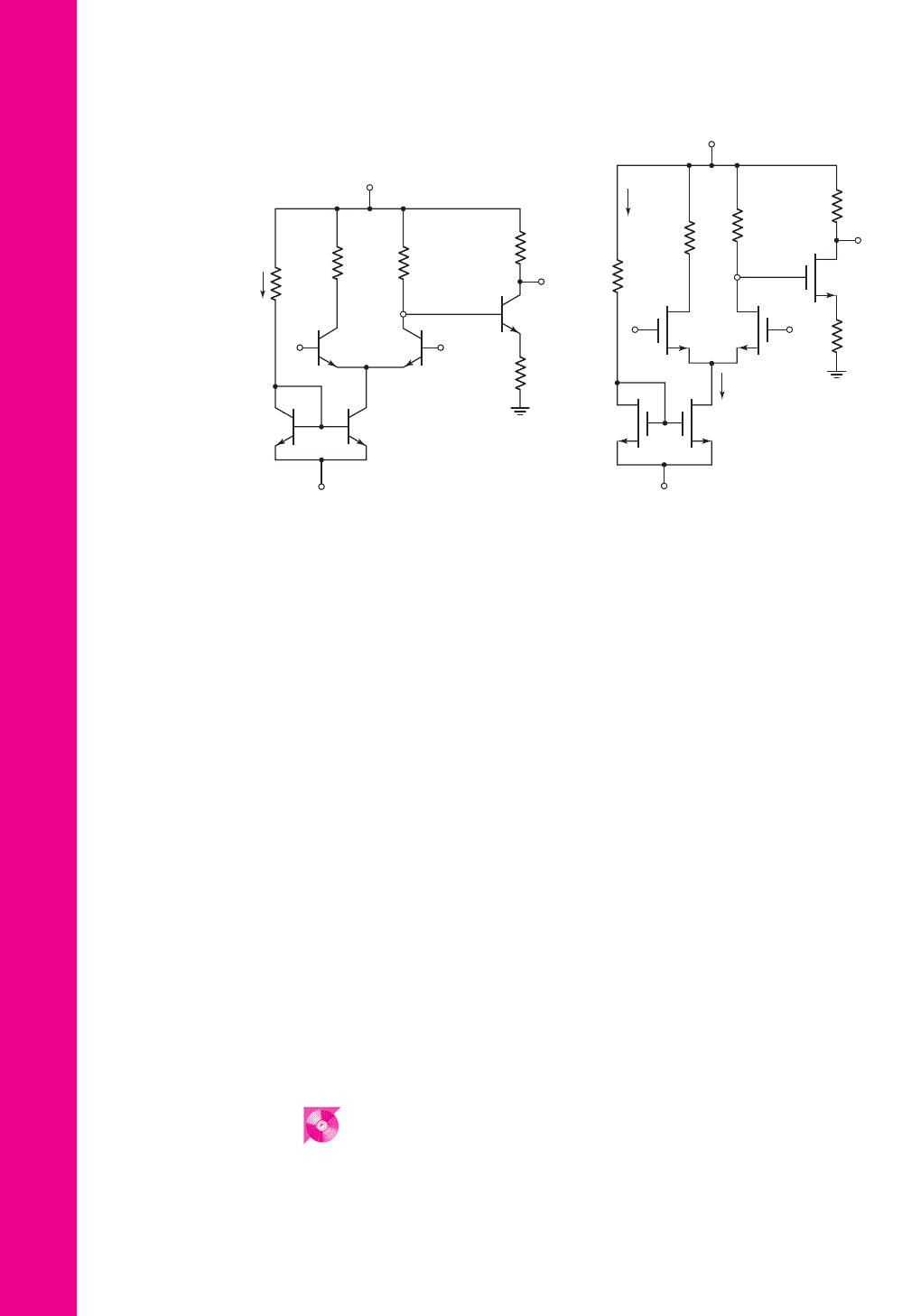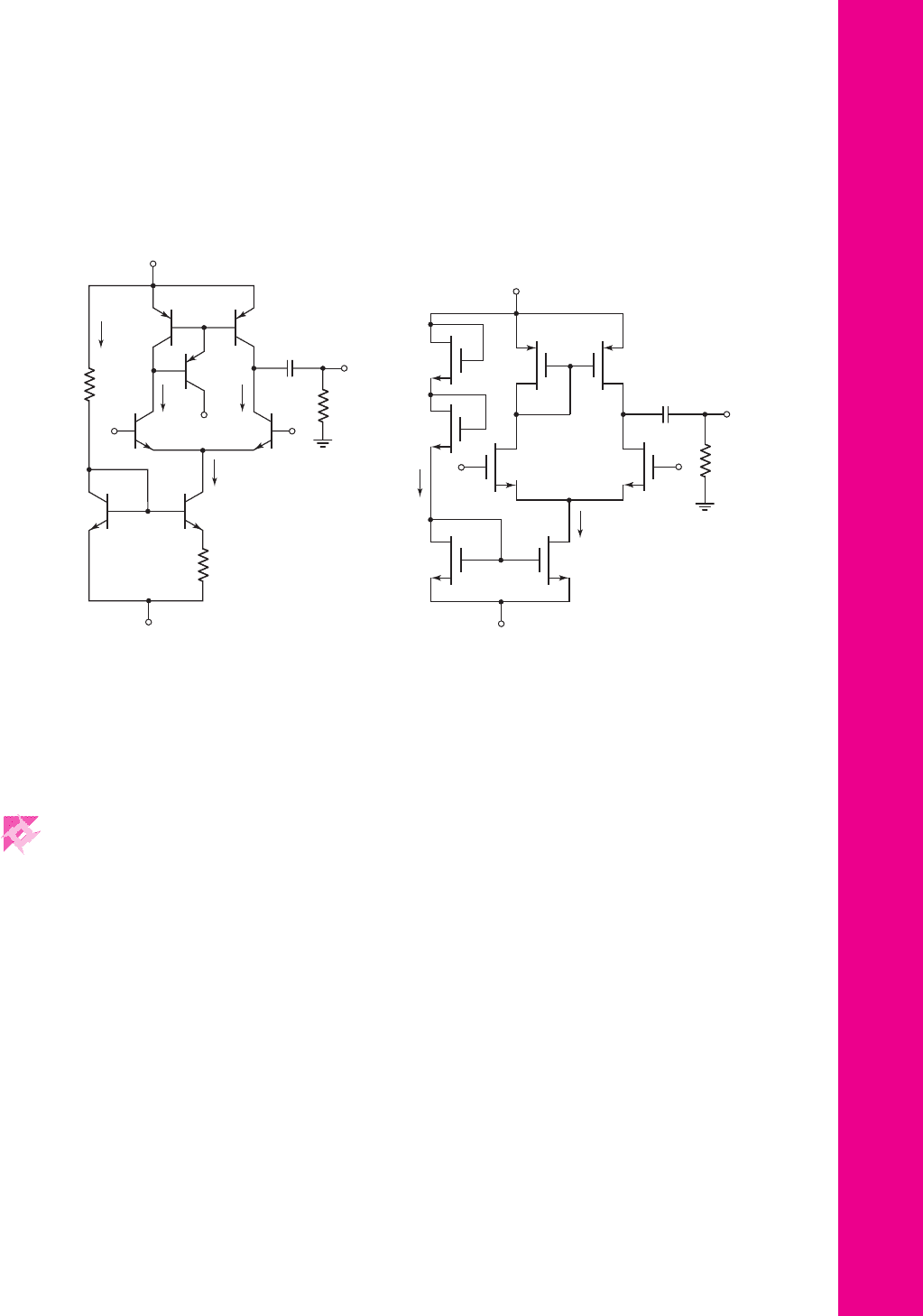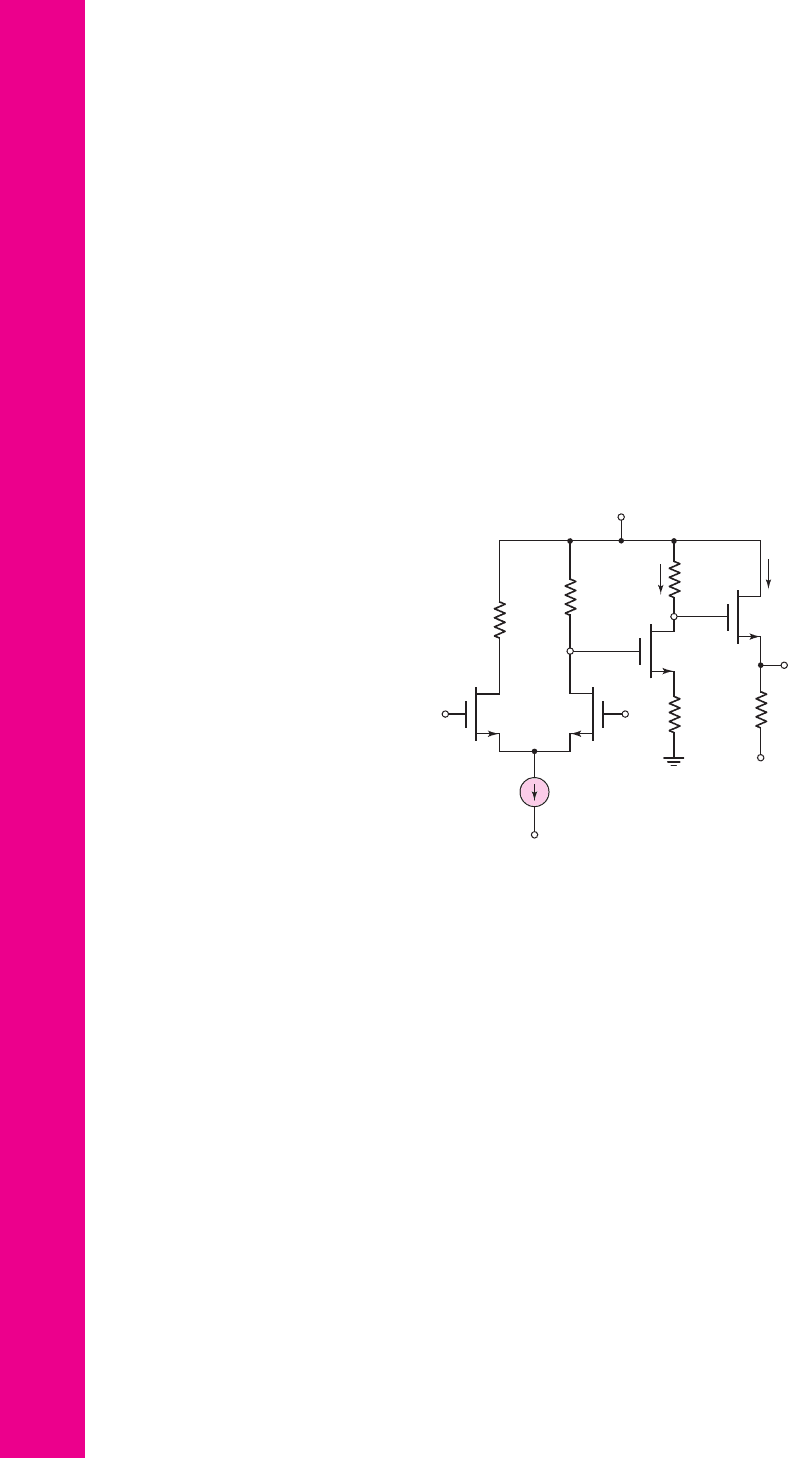Neamen D. Microelectronics: Circuit Analysis and Design
Подождите немного. Документ загружается.


848 Part 2 Analog Electronics
Section 11.8 Diff-Amp Frequency Response
11.94 Consider the differential amplifier in Figure 11.50(a) with parameters
I
Q
= 0.8
mA,
R
C
= 10
k
, and
R
B
= 0.5
k
. The transistor parameters
are
β = 150
,
V
BE
(
on
)
= 0.7
V,
V
A
=∞
,
C
π
= 1.2
pF, and
C
μ
= 0.2
pF.
(a) Determine the low-frequency differential-mode gain
A
d
= v
o2
/v
d
.
(b) Find the equivalent Miller capacitance of each transistor. (c) Determine
the upper 3 dB frequency.
11.95 The differential amplifier in Figure 11.51(a) has the same circuit and tran-
sistor parameters as described in Problem 11.94. The equivalent impedance
of the current source is
R
o
= 10
M
and
C
o
= 0.4
pF. (a) Determine the
frequency of the zero in the common-mode gain. (b) Find the frequency of
the pole in the common-mode gain.
11.96 A BJT diff-amp is biased with a current source
I
Q
= 2
mA, and the circuit
parameters are
R
C
= 10 k
and
R
B
= 1k
. The transistor parameters are:
β = 120
,
f
T
= 800
MHz, and
C
μ
= 1pF
. (a) Determine the upper 3 dB
frequency of the differential-mode gain. (b) If the current source impedance
parameters are
R
o
= 10 M
and
C
o
= 1
pF, find the frequency of the zero
in the common-mode gain.
11.97 Consider the diff-amp in Figure 11.55. The circuit and transistor parameters
are the same as in Problem 11.6. For a one-sided output at
v
o2
, determine the
differential-mode gain for: (a)
R
E
= 100
, and (b)
R
E
= 250
.
COMPUTER SIMULATION PROBLEMS
11.98 Using a computer simulation, verify the results of Example 11.12.
11.99 Using a computer simulation, verify the results of Example 11.13 for the
simple op-amp circuit.
V
+
= 12 V
V
–
= –12 V
R
1
=
12 kΩ
R
C
=
8 kΩ
R
C
= 8 kΩ
R
C2
= 4 kΩ
R
E
= 3.3 kΩ
v
O2
v
O3
I
1
Q
1
Q
4
Q
5
Q
3
Q
2
v
2
v
1
Figure P11.92
V
+
= 12 V
V
–
= –12 V
R
1
=
55 kΩ
M
1
M
2
M
4
M
5
M
3
R
5
=
6 kΩ
I
1
R
D2
= 4 kΩ
R
D
= 40 kΩ
R
D
=
40 kΩ
I
Q
v
O2
v
O3
v
2
v
1
Figure P11.93
nea80644_ch11_753-850.qxd 6/19/09 4:34 PM Page 848 pmath DATA-DISK:Desktop Folder:19/6/2009:MHDQ134-11 Folder:MHDQ134-11

Chapter 11 Differential and Multistage Amplifiers 849
11.100 Consider the circuit in Figure P11.100. Use standard transistors. Using
a computer simulation, determine the small-signal differential-mode
voltage gain and common-mode voltage gain for (a)
R
L
= 10
M
and
(b)
R
L
= 200
k
.
V
+
= 10 V
V
–
= –10 V
M
5
M
3
M
4
M
2
C → ∞
v
2
v
o
I
Q
v
1
I
1
M
1
M
6
M
7
M
8
R
L
Figure P11.101
V
+
= 10 V
V
–
= –10 V
V
–
= –10 V
R
1
=
20 kΩ
R
2
= 2 kΩ
I
1
I
C1
I
C2
I
Q
v
o
R
L
Q
3
Q
4
Q
5
C → ∞
Q
1
Q
2
v
2
v
1
Q
7
Q
6
Figure P11.100
11.101 Consider the circuit in Figure P11.101. Use standard transistors. Using a
computer simulation, determine the small-signal differential-mode volt-
age gain and common-mode voltage gain for (a)
R
L
= 10
M
and
(b)
R
L
= 200
k
.
DESIGN PROBLEMS
[Note: Each design is to be correlated with a computer simulation analysis.]
*D11.102 Design a basic BJT diff-amp with an active load and constant current-
source biasing. The bias voltages are to be
±3
V and the maximum power
dissipation is to be limited to 2 mW. The open-circuit differential-mode
voltage gain should be
|
A
d
|
= 1800
and the common-mode rejection
ratio should be
CMRR
dB
= 75
dB. Specify bias currents, minimum Early
voltages, and the minimum output impedance of the current source. De-
sign the current source to achieve the required output impedance.
*D11.103 Design a basic MOSFET diff-amp with an active load and constant cur-
rent-source biasing. The bias voltages are to be
±3
V and the maximum
power dissipation is to be limited to 2 mW. The open-circuit differential-
mode voltage gain should be
|
A
d
|
= 180
and the common-mode rejec-
tion ratio should be
CMRR
dB
= 80
dB. Use appropriate transistor para-
meters. Specify bias currents, minimum
λ
values, and the minimum
output impedance of the current source. Design the current source to
achieve the required output impedance.
nea80644_ch11_753-850.qxd 6/19/09 4:34 PM Page 849 pmath DATA-DISK:Desktop Folder:19/6/2009:MHDQ134-11 Folder:MHDQ134-11

*D11.104 Consider the bipolar op-amp configuration in Figure 11.49. The bias volt-
ages are
±10
V, as shown, the current I
R7
is to be
I
R7
= 3
mA, and the
maximum dc power dissipation in the circuit is to be l20 mW. The output
voltage is to be
v
o
= 0
for
v
1
= v
2
= 0
. Design the circuit, using reason-
able resistance and current values. What is the overall differential-mode
voltage gain?
*D11.105 The transistor parameters for the circuit in Figure P11.105 are:
K
n
=
0.2 mA/V
2
,
V
TN
= 0.8
V, and
λ = 0
. The output resistance of the
constant-current source is
R
o
= 100 k
. (a) For
v
1
= v
2
= 0
, design the
circuit such that:
v
o2
= 2
V,
v
o3
= 3
V,
v
o
= 0
,
I
DQ3
= 0.25
mA, and
I
DQ4
=
2 mA. (b) Determine the differential-mode gains
A
d1
= v
o2
/v
d
and
A
d
= v
o
/v
d
. (c) Determine the common-mode voltage gains
A
cm1
=
v
o2
/v
cm
and
A
cm
= v
o
/v
cm
, and the overall CMRR
dB
.
850 Part 2 Analog Electronics
R
R
I
DQ4
v
O
v
O2
I
Q
= 0.5 mA
v
1
M
1
M
2
M
3
M
4
v
2
I
DQ3
R
D
R
S1
R
S2
V
+
= 5 V
V
–
= –5 V
V
–
= –5 V
v
O3
Figure P11.105
nea80644_ch11_753-850.qxd 6/19/09 4:38 AM Page 850 pmath DATA-DISK:Desktop Folder:18.6.09:MHDQ134-11:

Chapter
851
Previously, we found that the small-signal voltage gain and other characteristics of
BJT and MOSFET circuit amplifiers are functions of, for example, the bipolar cur-
rent gain and the MOSFET conduction parameter. In general, these transistor para-
meters vary with temperature and have a range of values for a given type of transistor,
because of processing and material property tolerances. These parameter variations
mean that the Q-point, voltage gain, and other circuit properties can vary from one
circuit to another, and can be functions of temperature.
Transistor circuit characteristics can be made essentially independent of the
individual transistor parameters by using feedback. The feedback process takes a
portion of the output signal and returns it to the input to become part of the input
excitation. We previously encountered feedback in our study of ideal op-amps and
op-amp circuits. For example, resistors are connected between the output and input
terminals of an ideal op-amp to form a feedback network. The voltage gain of these
ideal circuits is a function only of the ratio of resistors and not of any individual tran-
sistor parameters. In this chapter, we formally study feedback and feedback circuits.
PREVIEW
In this chapter, we will:
• Introduce feedback concepts and discuss, in general terms, advantages and
disadvantages of using feedback in electronic circuits.
• Derive the transfer function of the ideal feedback system and determine a few
characteristics of the feedback system.
• Analyze the four ideal feedback circuit configurations and determine circuit
characteristics including input and output resistances.
• Analyze op-amp and discrete transistor circuit examples of voltage feedback
amplifiers, current feedback amplifiers, transconductance feedback ampli-
fiers, and transresistance feedback amplifiers.
• Derive the loop-gain of ideal and practical feedback circuits.
• Determine the stability criteria of feedback circuits.
• Consider frequency compensation techniques, methods by which unstable
feedback circuits can be stabilized.
• As an application, redesign a BJT feedback circuit using MOSFETs.
Feedback
and Stability
12
12
nea80644_ch12_851-946.qxd 6/25/09 11:22 AM Page 851 VK TEMPWORK:Desktop Folder:25/06/09pp:MHDQ134-12:

852 Part 2 Analog Electronics
12.1 INTRODUCTION TO FEEDBACK
Objective: • Introduce feedback concepts and discuss, in general
terms, a few advantages and disadvantages of using feedback in
electronic circuits.
Feedback is used in virtually all amplifier systems. Harold Black, an electronics en-
gineer with the Western Electric Company, invented the feedback amplifier in 1928
while searching for methods to stabilize the gain of amplifiers for use in telephone re-
peaters. In a feedback system, a signal that is proportional to the output is fed back to
the input and combined with the input signal to produce a desired system response.
As we will see, external feedback is used deliberately to achieve particular system
benefits. However, feedback may be unintentional and an undesired system response
may be produced.
We have already seen examples of feedback in previous chapters, although the
term feedback may not have been used. For example, in Chapters 3 and 5 we intro-
duced resistors at the emitter of BJT common-emitter circuits and at the source of
MOSFET common-source circuits to stabilize the Q-point against variations in tran-
sistor parameters. This technique introduces negative feedback in the circuit. An
increase in collector or drain current produces an increase in the voltage across
these resistors which produces a decrease in the base-emitter or gate-source voltage.
The decrease in these device voltages tends to reduce or oppose the change in col-
lector or drain current. Opposition to change is suggested by use of the term negative
feedback.
Feedback can be either negative or positive. In negative feedback, a portion of
the output signal is subtracted from the input signal; in positive feedback, a portion
of the output signal is added to the input signal. Negative feedback, for example,
tends to maintain a constant value of amplifier voltage gain against variations in tran-
sistor parameters, supply voltages, and temperature. Positive feedback is used in the
design of oscillators and in a number of other applications. In this chapter, we will
concentrate on negative feedback.
Advantages and Disadvantages
of Negative Feedback
Before we actually get into the analysis and design of feedback circuits, we will list
some of the advantages and disadvantages of negative feedback. Although these
characteristics and properties of negative feedback are not obvious at this point, they
are listed here so that the reader can anticipate these results during the derivations
and analysis.
Advantages
1. Gain sensitivity. Variations in the circuit transfer function (gain) as a result of
changes in transistor parameters are reduced by feedback. This reduction in
sensitivity is one of the most attractive features of negative feedback.
2. Bandwidth extension. The bandwidth of a circuit that incorporates negative
feedback is larger than that of the basic amplifier.
12.1.1
nea80644_ch12_851-946.qxd 6/23/09 1:45 PM Page 852 pmath DATA-DISK:Desktop Folder:23/06/09:MHDQ134-12:

3. Noise sensitivity. Negative feedback may increase the signal-to-noise ratio if
noise is generated within the feedback loop.
4. Reduction of nonlinear distortion. Since transistors have nonlinear character-
istics, distortion may appear in the output signals, especially at large signal
levels. Negative feedback reduces this distortion.
5. Control of impedance levels. The input and output impedances can be in-
creased or decreased with the proper type of negative feedback circuit.
Disadvantages
1. Circuit gain. The overall amplifier gain, with negative feedback, is reduced
compared to the basic amplifier used in the circuit.
2. Stability. There is a possibility that the feedback circuit may become unstable
(oscillate) at high frequencies.
These advantages and disadvantages will be further discussed as we develop the
feedback theory.
In the course of our discussion, we will analyze several feedback circuits, in both
discrete and op-amp circuit configurations. First, however, we will consider the ideal
feedback theory and derive the general characteristics of feedback amplifiers. In this
section, we discuss the ideal signal gain, gain sensitivity, bandwidth extension, noise
sensitivity, and reduction of nonlinear distortion of a generalized feedback amplifier.
Use of Computer Simulation
Conventional methods of analysis that have been used in the previous chapters apply
directly to feedback circuits. That is, the same dc analysis techniques and the same
small-signal transistor equivalent circuits apply directly to feedback circuits in this
chapter. However, in the analysis of feedback circuits, several simultaneous equa-
tions can be obtained, the time involved may be quite long and the probability of in-
troducing errors may become almost certain.
Therefore, computer simulation of feedback circuits may prove to be very use-
ful and is used fairly often throughout this chapter. As always, a word of warning is
in order concerning computer simulation. Computer simulation does not replace
basic understanding. It is important for the reader to understand the concepts and
characteristics of the basic types of feedback circuits. Computer simulation is used
only as a tool for obtaining specific results.
12.2 BASIC FEEDBACK CONCEPTS
Objective: • Analyze and obtain the transfer function of the ideal
feedback system, and determine a few characteristics (advantages) of
the feedback system.
Figure 12.1 shows the basic configuration of a feedback amplifier. In the diagram, the
various signals S can be either currents or voltages. The circuit contains a basic
amplifier with an open-loop gain A and a feedback circuit that samples the output
12.1.2
Chapter 12 Feedback and Stability 853
nea80644_ch12_851-946.qxd 6/23/09 1:45 PM Page 853 pmath DATA-DISK:Desktop Folder:23/06/09:MHDQ134-12:

+
–
S
fb
S
i
S
ε
So
Source
Load
A
Σ
b
Figure 12.1 Basic configuration of a feedback amplifier
signal and produces a feedback signal
S
fb
. The feedback signal is subtracted from the
input source signal, which produces an error signal
S
ε
. The error signal is the input
to the basic amplifier and is the signal that is amplified to produce the output signal.
The subtraction property produces the negative feedback.
Implicit in the diagram in Figure 12.1 is the assumption that the input signal is
transmitted through the amplifier only, none through the feedback network, and that the
output signal is transmitted back through the feedback network only, none through the
amplifier. Also, there are no loading effects in the ideal feedback system. The feedback
network does not load down the output of the basic amplifier, and the basic amplifier
and feedback network do not produce a loading effect on the input signal source. In
actual feedback circuits, these assumptions and conditions are not entirely accurate.
We will see later how nonideal conditions change the characteristics of actual feedback
circuits with respect to those of the ideal feedback network.
854 Part 2 Analog Electronics
1
In this chapter,
β
is the feedback transfer function, rather than the transistor current gain. The parameter
h
FE
will be used as the transistor current gain. Normally,
h
FE
indicates the dc current gain and
h
fe
indi-
cates the ac current gain. However, as usual, we neglect any difference between the two parameters and
assume
h
FE
= h
fe
.
Ideal Closed-Loop Signal Gain
From Figure 12.1, the output signal is
S
o
= AS
ε
(12.1)
where A is the amplification factor, and the feedback signal is
S
fb
= β S
o
(12.2)
where
β
in this case is the feedback transfer function.
1
At the summing node, we
have
S
ε
= S
i
− S
fb
(12.3)
where S
i
is the input signal. Equation (12.1) then becomes
S
o
= A(S
i
−β S
o
) = AS
i
−β AS
o
(12.4)
Equation (12.4) can be rearranged to yield the closed-loop transfer function, or
gain, which is
A
f
=
S
o
S
i
=
A
(1 + β A)
(12.5)
As mentioned, signals S
i
, S
o
,
S
fb
, and
S
ε
can be either currents or voltages; how-
ever, they do not need to be all voltages or all currents in a given feedback amplifier.
12.2.1
nea80644_ch12_851-946.qxd 6/23/09 1:45 PM Page 854 pmath DATA-DISK:Desktop Folder:23/06/09:MHDQ134-12:

In other words, there may be a combination of current and voltage signals in the same
circuit.
Equation (12.5) can be written
A
f
=
A
(1 + β A)
=
A
1 + T
(12.6)
where
T = β A
is the loop gain. For negative feedback, we assume T to be a pos-
itive real factor. We will see later that the loop gain can become a complex func-
tion of frequency, but for the moment, we will assume that T is positive for neg-
ative feedback. We will also see that in some cases the gain will be negative
(180 degree phase difference between input and output signals) which means that
the feedback transfer function
β
will also be a negative quantity for a negative
feedback circuit.
Combining Equations (12.1) and (12.2), we obtain the loop gain relationship
T = Aβ =
S
fb
S
ε
(12.7)
Normally, the error signal is small, so the expected loop gain is large. If the loop gain
is large so that
β A 1
, then, from Equation (12.6), we have
A
f
∼
=
A
β A
=
1
β
(12.8)
and the gain or transfer function of the feedback amplifier essentially becomes a
function of the feedback network only.
The feedback circuit is usually composed of passive elements, which means
that the feedback amplifier gain is almost completely independent of the basic
amplifier properties, including individual transistor parameters. Since the feed-
back amplifier gain is a function of the feedback elements only, the closed-loop
gain can be designed to be a given value. This property was demonstrated in
Chapter 9, where we showed that the closed-loop gain of ideal op-amp circuits is
a function of the feedback elements only. The individual transistor parameters
may vary widely, and may depend on temperature and frequency, but the feedback
amplifier gain is constant. The net results of negative feedback is stability in the
amplifier characteristics.
In general, the magnitude and phase of the loop gain are functions of frequency,
and they become important when we discuss the stability of feedback circuits.
EXAMPLE 12.1
Objective: Calculate the feedback transfer function
β
, given A and A
f
.
Case A. Assume that the open-loop gain of a system is
A = 10
5
and the
closed-loop gain is
A
f
= 50
.
Solution: From Equation (12.5), the closed-loop gain is
A
f
=
A
(1 + β A)
or
50 =
10
5
1 + β(10
5
)
which yields
β = 0.01999
or
1/β = 50.025
.
Chapter 12 Feedback and Stability 855
nea80644_ch12_851-946.qxd 6/23/09 1:45 PM Page 855 pmath DATA-DISK:Desktop Folder:23/06/09:MHDQ134-12:

Case B. Now assume that the open-loop gain is
A =−10
5
and the close-loop
gain is
A
f
=−50
.
Solution: Again, from Equation (12.5), the closed-loop gain is
A
f
=
A
(1 + β A)
or
−50 =
−10
5
1 + β(−10
5
)
which yields
β =−0.01999
or
1/β =−50.025
.
Comment: From these typical parameter values, we see that
A
f
∼
=
1/β
, as Equa-
tion (12.8) predicts. We also see that if the open-loop gain A is negative, then the
closed-loop gain A
f
and feedback transfer function
β
will also be negative for a neg-
ative feedback network.
EXERCISE PROBLEM
Ex 12.1: (a) The open-loop gain of an amplifier is
A = 5 ×10
4
and the closed-loop
gain is
A
f
= 50
. (i) What is the feedback transfer function? (ii) What is the ratio of
A
f
to
1/β
? (b) Repeat part (a) for
A = 100
and
A
f
= 20
. (Ans. (a) (i) 0.01998,
(ii) 0.9990; (b) (i) 0.04, (ii) 0.80)
Assuming a large loop gain, the output signal, from Equation (12.5), becomes
S
o
=
A
1 + β A
S
i
∼
=
1
β
· S
i
(12.9)
Substituting Equation (12.9) into (12.3), we obtain the error signal,
S
ε
= S
i
−β S
o
∼
=
S
i
−β
S
i
β
= 0
(12.10)
With a large loop gain, the error signal decreases to almost zero. We will see this
result again as we consider specific feedback circuits throughout the chapter.
Gain Sensitivity
As previously stated, if the loop gain
T = β A
is very large, the overall gain of the
feedback amplifier is essentially a function of the feedback network only. We can
quantify this characteristic.
If the feedback transfer function
β
is a constant, then taking the derivative of A
f
with respect to A, from Equation (12.5), produces
dA
f
dA
=
1
(1 + β A)
−
A
(1 + β A)
2
· β =
1
(1 + β A)
2
(12.11(a))
or
dA
f
=
dA
(1 + β A)
2
(12.11(b))
Dividing both sides of Equation (12.11(b)) by the closed-loop gain yields
dA
f
A
f
=
dA
(1 + β A)
2
A
1 + β A
=
1
(1 + β A)
·
dA
A
=
A
f
A
dA
A
(12.12)
12.2.2
856 Part 2 Analog Electronics
nea80644_ch12_851-946.qxd 6/23/09 1:45 PM Page 856 pmath DATA-DISK:Desktop Folder:23/06/09:MHDQ134-12:

Chapter 12 Feedback and Stability 857
Equation (12.12) shows that the percent change in the closed-loop gain A
f
is
less than the corresponding percent change in the open-loop gain A by the factor
(
1 + β A
). The change in open-loop gain may result from variations in individual
transistor parameters in the basic amplifier.
EXAMPLE 12.2
Objective: Calculate the percent change in the closed-loop gain A
f
, given a change
in the open-loop gain A.
Using the same parameter values as in Example 12.1, we have
A = 10
5
,
A
f
= 50
, and
β = 0.01999
. Assume that the change in the open-loop gain is
dA= 10
4
(a 10 percent change).
Solution: From Equation (12.12), we have
dA
f
=
A
f
(1 + β A)
·
dA
A
=
50
[1 + (0.01999)(10
5
)]
·
10
4
10
5
= 2.5 ×10
−3
The percent change is then
dA
f
A
f
=
2.5 × 10
−3
50
= 5 ×10
−5
⇒ 0.005%
compared to the 10 percent change assumed in the open-loop gain.
Comment: From this example, we see that the resulting percent change in the
closed-loop gain is substantially less than the percent change in the open-loop gain.
This is one of the principal advantages of negative feedback.
EXERCISE PROBLEM
Ex 12.2: (a) Consider a general feedback system with parameters
A = 5 ×10
5
and
A
f
= 50
. If the magnitude of
A
decreases by 15 percent, what is the new
value of
A
f
and what is the corresponding percent change in
A
f
? (b) Repeat
part (a) if
A = 100
and
A
f
= 20
. (Ans. (a)
A
f
= 49.99912
,
−1.76 × 10
−3
%
;
(b)
A
f
= 19.318
,
−3.41%)
From Equation (12.12), the change in A
f
is reduced by the factor (
1 + β A
) com-
pared to the change in A. The term (
1 + β A
) is called the desensitivity factor.
Bandwidth Extension
The amplifier bandwidth is a function of feedback. Assume the frequency response
of the basic amplifier can be characterized by a single pole. We can then write
A(s) =
A
o
1 +
s
ω
H
(12.13)
where A
o
is the low-frequency or midband gain, and
ω
H
is the upper 3 dB or corner
frequency.
12.2.3
nea80644_ch12_851-946.qxd 6/23/09 1:45 PM Page 857 pmath DATA-DISK:Desktop Folder:23/06/09:MHDQ134-12:
